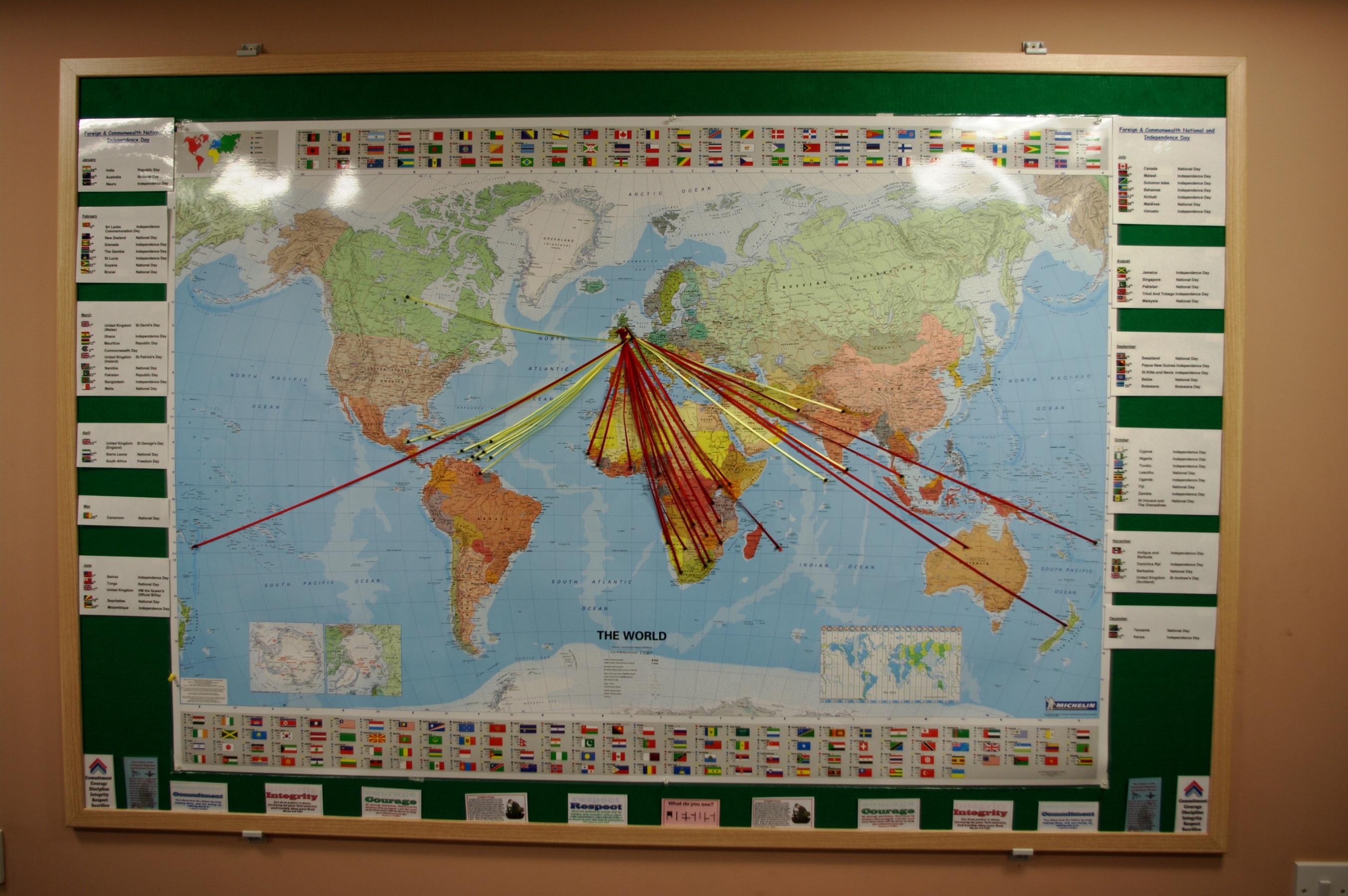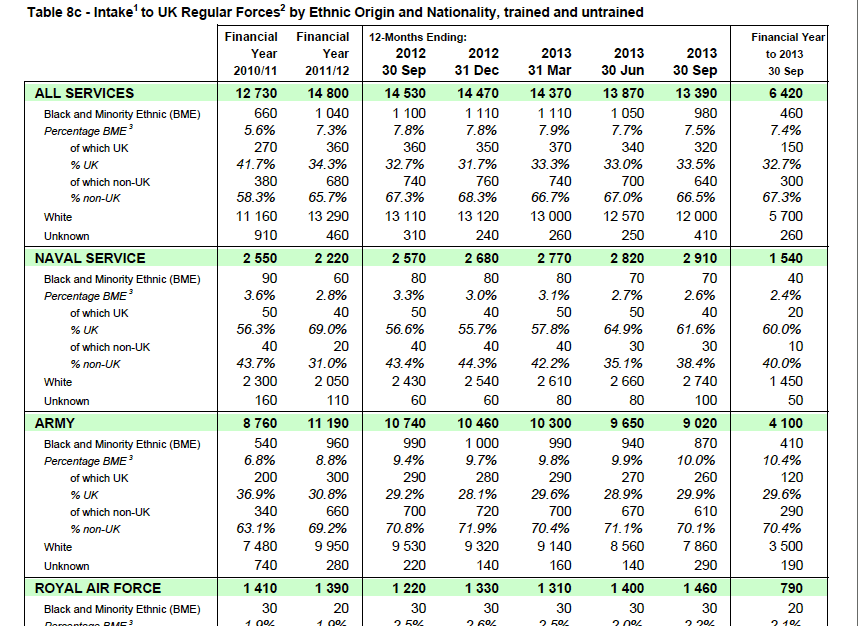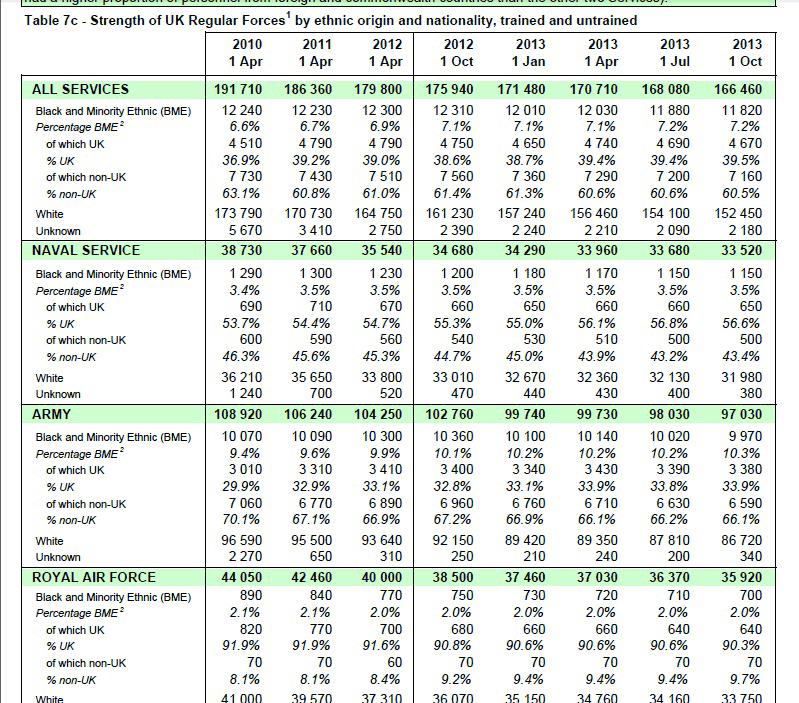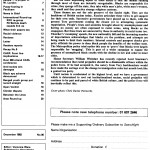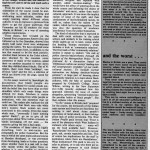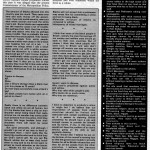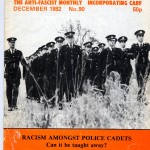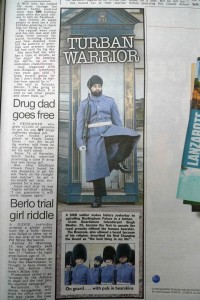The significance of Muslims serving in the UK military has been highlighted several times in the last few days, both times in relation to the killing of a soldier in Woolwich. The first was by Paul Goodman on the conservativehome website. In a longer piece on the implications of a terror attack committed by Islamists in the UK he said:
Islam is compatible with democracy, Islamism is not – but politicians have neither the knowledge nor the mandate to help shape “a British Islam”. Perhaps all they can do is run an effective security strategy, and make limited political progress. The latter would include recruiting more Muslims into the armed forces – there were about 600 in 2010: one of the biggest barriers to recruitment, according to Shiraz Maher’s Ties That Bind, is that young Muslims are unaware that the opportunity to join is there at all. (Maher’s pamphlet for Policy Exchange tells the story of how hundreds of thousands of Muslims fought for Britain in two world wars.)
Here we note that offering young British Muslims the chance to join the armed forces would constitute ‘limited political progress’.
The second piece approached the subject of Muslims in the armed forces head on, and from the perspective of an ex-army officer and member of the Armed Forces Muslim Association. Afzal Amin’s article, published in the Guardian comment is free section, was entitled: ‘Extremists will not divide our armed forces’. Amongst other things he wrote:
As we witness this brutality in Woolwich, more than 600 Muslim personnel are deployed in Afghanistan, Mali, Somalia and elsewhere, contributing to our collective security. This attack is not connected to them, nor the armed forces, who have helped so many Muslims in Iraq and Afghanistan – two theatres in which the principal beneficiaries of military intervention have been Muslim civilians and their governments.
So in addition to contributing to a functioning diverse and cohesive military, he claimed, Muslim soldiers can also perform useful security functions while they are at it – symbolically as well as practically in terms of culture and language.
Amin’s pitch, overtly politicised by virtue of the fact that he is a Tory parliamentary candidate, was subsequently reiterated in an interview in the Independent. Under the headline: “Terror in Woolwich – a soldier’s tale: UK Muslims – your country needs you” he said:
The Prophet Mohamed said: ‘Love for one’s nation is part of faith’; ‘Who serves a people is the best of them’, and that ‘the Muslim is the one from whose hands and tongue others are safe’. The motto of Sandhurst is ‘Serve to Lead’. These are all British values and Islamic values,” he says.
Having left the army in April he is now free to claim that in his last deployment in Afghanistan in 2012 he acted as “a strategist advising US generals on conflict termination strategy through civil society engagement and empowerment”.
So how did that go? Clearly the mundane practice of “diversity” in this secretive and defensive institution entails something more than vague notions of inclusion and representativeness.
While there are indeed important things to say about this, there are underlying questions about how and why the military has come to dominate national public life, and why military service now carries such weight as a profession unlike any other.
This short piece below briefly outlines the significance of Muslims serving in the British military today. (However, it summarises a much longer discussion in the book which looks at racism inside the armed forces as well as the the concept of “militarised multiculture”.)
Muslims and Military Service
In 2006 Jabron Hashmi, 24, became the first British Muslim soldier to die in Afghanistan. His older brother, Zeeshan, who had also worked in the British Army, said at the time: ‘Jabron was a committed soldier and a committed Muslim. He was fiercely proud of his Islamic background and he was equally proud of being British and was very proud to live in Britain.’
The death in service of this avowedly Muslim patriot was acknowledged as a significant event at the highest levels. The following year members of Hashmi’s family, who lived in Birmingham and were originally from Pakistan, were asked to lay the foundation stone for the new National Memorial Arboretum in Staffordshire. However, although Jabron’s death was commemorated as a form of sacrifice for the nation, it was also perceived as an act of betrayal by many other Muslims.
In a BBC report entitled ‘UK’s Muslim soldiers “fighting extremists not Muslims”’, Zeeshan Hashmi subsequently revealed that, following Jabron’s death, the family had received many letters from ‘well-wishers of all faith and backgrounds’, which had a great source of comfort. But they had also experienced hostility on the grounds that Jabron was considered a traitor.
These divergent responses help to illustrate why the figure of the Muslim performing military service is so significant. At one extreme, as a British soldier, Jabron Hashmi was hailed as a hero who gave his life for his country. For others, as a Muslim, he was accused of betraying his faith by fighting in a war that demonised Islam as the enemy of western civilisation. Yet it is not often that we hear about the experience of minorities, particularly those who are Muslims, who decide to work in the armed forces.
The most recent statistics published by the Ministry of Defence (MoD) indicate that there are 650 Muslims serving in the UK armed services.[ii] Of these, 550 are in the British Army, constituting 0.5% of the total. In common with other faith groups, Muslim servicemen and women maintain a network of mutual support known as the Armed Forces Muslim Association (AFMA). So what does this tell us about the conditions of diversity in the army?
A modern multicultural military?
Within the past decade the MoD has been able to claim that, in terms of numbers, the proportion of black and minority ethnic personnel in all three services has risen from just over one per cent to more than seven per cent. In the British Army, the figure currently hovers around ten per cent.
This rise can partly be explained by the fact that residency regulations for Commonwealth citizens were dropped in 1998, partly in response to a documented levels of racism and the virtual absence of diversity in the workforce. Today, two thirds of BME personnel are classified as ‘foreign and Commonwealth’, and this figure does not include Gurkhas who are recruited from Nepal.[iii] The employment of soldiers from outside the UK has had a significant impact on the institution’s progression towards becoming a multicultural (and multi-faith) employer. But this process of modernisation has also been mandated by law.
In 2003 the religion and belief elements of the European Employment Framework Directive were incorporated into the UK Employment Equality Regulations. Two years later the appointment of Buddhist, Muslim, Sikh and Hindu chaplains replaced a system whereby religious leaders were engaged simply as advisers. For Muslims, as for other faith groups, this reform meant the possibility of a support network for individuals scattered across the institution.
Diversity as a martial asset
When Imam Asim Hafiz took up the post of first Muslim chaplain in 2005, it was unclear how many Muslims were serving since comprehensive statistics were only collected from 2007. By 2009, there were 500 Muslims in the regular armed forces. Over four hundred of these were in the army, and a significant proportion were citizens of countries such as The Gambia, Ghana, Nigeria and Pakistan. It was at this point that AFMA was set up with the licence to explore the wider issue of Muslims serving in the military.
In the first newsletter, Imam Hafiz explained how the group hoped to persuade civilians about the significance of their work:
“Unfortunately there is a huge … ignorance in some parts of the Muslim community and I hope that AFMA will be able to bridge the gap between the Armed Forces and the Muslim community and be a reminder that HM Forces are as integral to British society as are other British institutions such as the Police Force, the fire service and the NHS that are here to serve this nation as whole including the Muslim community.”[iv]
The Imam was supported by the Muslim Council of Britain (MCB) in his expressed aims to educate the Muslim community about the opportunities provided by military service. The MCB issued a report entitled Remembering the Brave: The Muslim Contribution to Britain’s Armed Forces in which they confront the issue, not just of ignorance about what it might mean to serve in the military, but also the depth of hostility towards the government’s foreign policy. The report asserts that ‘Loyalty does not mean the suspension of our critical faculties and failure to question our contested national engagements.’[v]
In an oblique reference to documented war crimes, such as the murder of civilian Baha Mousa in September 2003, committed by British soldiers in Iraq, the report ventures into more controversial territory: ‘We should ensure that the actions of a few does not diminish the overall expectations of our armed forces to abide by international laws of war and uphold fundamental human rights.’
While these arguments are addressed to UK citizens at home, the organization of Muslims inside the armed forces has been acknowledged by sections of the military leadership too. In 2009 the then Chief of the General Staff, General Sir David Richards, the first patron of the AFMA, commented publicly that Britain ‘had a commitment to … all those Muslims with whom we have a natural identity, given our own core values reflect very strongly to those of Muslim faith.[vi]
The raised profile of Muslim personnel – including the Imam – has also been utilised as a strategic asset in Afghanistan. This could be seen in news reports emphasising the participation of Muslims, whether joining forces with Afghan security personnel to celebrate Eid or acting as intermediaries with Afghan civilians.[vii] Seen in this light, the pragmatic tools of counter-insurgency warfare intersect with the symbolic aspects of soldiering on the domestic front.
[i] Armed Forces Muslim Association see http://www.afma.org.uk
[ii] UK Defence Statistics, April 2012. Chapter 2. Personnel. Table 2.12 Strength of UK Regular Forces by Service and religion, at 1 April each year. Defence Analytical Services Agency.
[iii] Ministry of Defence. Biannual Diversity Dashboard. 01 October 2012.
Section 2 – Ethnic origin and nationality representation of UK Regular Forces by Service.
[iv] Imam Asim Hafiz, ‘The love of your country is part of your faith’. AFMA Newsletter, July 2010, p. 7.
[v] ‘The Armed Forces reflecting Modern Britain: the Muslim contribution today’ in Remembering the Brave: The Muslim Contribution to Britain’s Armed Forces. A special report by the Muslim Council of Britain. (2009-2010 – Not dated), p. 9.
[vi] In the same interview Richards also said, ‘It is very important for the Muslim community to be exposed to an alternative view as it is for the rest of the nation. The Taliban kill many more Muslims than we do.’
[vii] See, for example: On November 16 2010 the Muslim chaplain gave a sermon to a multi-national congregation in the festival of Eid ul Adha in conjunction with the Imam of the local 205 Corps of the Afghan National Army (ANA). A lengthy report in the MoD’s Defence News site revealed that there were 600 Muslims present, including representatives from across ISAF military forces, defence contractors and civilian workers as well as ‘local Afghans’. The occasion was hailed as a reflection of ‘the united relationship’ between ISAF and the Afghan National Army (MoD, Defence News, 2012).

